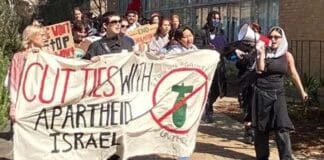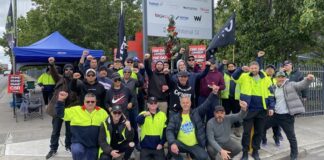The brutal attack by NSW police on Jamie Jackson at the recent Lesbian and Gay Mardi Gras, exposed on YouTube, has raised question marks over common sense ideas in society about the police and homophobia.
It has also enraged, with a snap demonstration organised in two days attracting more than 2000 people in Sydney.
Police and some media are using a new video showing Jamie’s altercations with police beforehand to justify the violence they later used. But nothing justifies throwing a small man to the ground and cracking his head against the pavement. Nor does the new footage explain why on earth police had detained Jamie in the first place. The offences he has been charged with only occurred after he was apprehended.
The attack on Jamie was not an isolated incident. Gay activist Bryn Hutchinson was also attacked by the police that night—hog-tied, kicked and stood on—for trying to cross the road. There are also reports of people being strip searched by police.
Institutional homophobia
There is a long history of police violence against LGBT people. The very first Mardi Gras in 1978 was violently attacked by police. The subsequent campaign to drop the charges against activists actually succeeded in winning the right to march in Sydney.
These activists challenged homophobia across society and made it possible for there to be open acceptance of LGBT people.
It is now possible in Australia to live a life outside the closet and find some acceptance. However, the very success of the LGBT movement has conservatised elements of it. Mardi Gras is now a mainstream, and very corporate, event. Major companies compete for the “pink dollar” and for the profits from LGBT venues, festivals and products. And the police, once seen as key agents of homophobic abuse, are now invited to participate in Mardi Gras.
But homophobia doggedly persists. A survey in 2005, outlined in Mapping Homophobia in Australia, reported that 35 per cent of people still think homosexuality is immoral. In the 2011 report Writing Themselves in Again by Gay and Lesbian Health Victoria on same-sex attracted young people 61 per cent report experiencing verbal abuse because of their sexuality and 18 per cent reported physical abuse. Any LGBT person can attest to their own experience of abuse.
That is because despite homophobia still has a structural basis in our society. It is legitimised by both major parties, who insist on refusing same-sex marriage despite the widespread public support for it. This encourages homophobia across society.
These politicians regularly invoke “family values” and “traditional marriage” to defend discrimination against LGBT people. They do so because the nuclear family has a particular value in a system geared towards profit. It helps generate the next generation of workers, free of any costs on the state and business.
With both major parties totally oriented to pleasing business and running the system—look at how Labor appeased the mining companies—it is no surprise they want to cling to this homophobia as much as possible.
Alongside that, Labor is consumed in a race to the right with Tony Abbott for electoral advantage, and are unprepared to challenge the fringe conservative ideology of people like the Australian Christian Lobby.
Police violence
The consequences of homophobia create the circumstances where LGBT people come into contact with police more often. But rather than being responsible for dealing with the causes of homophobia, police are responsible for getting people “off the streets”, charging them with petty crime, policing drinking venues, and so on. In the course of enforcing these kinds of laws, police adopt a particularly virulent hatred of the minority groups and poor people they find themselves policing.
So it should not come as a surprise that this can express itself in disregard for our lives and safety, and in disgusting acts of abuse, as it did at Mardi Gras this year.
The same attitudes are visible in the police’s treatment of other minority groups—take for instance the horrific rates of Aboriginal deaths in custody, or the killing of Brazilian student Roberto Curti, who died after being tasered by police 14 times.
One estimate suggests that only 15 per cent of homophobic abuse is reported to the police. This is a sign of how people instinctively recognise that the police do not take homophobia seriously.
The early radicals who paved the way for LGBT rights argued that the structural roots of homophobia needed to be uprooted if society was to become truly and fully accepting of LGBT people.
Today, as much as in 1978, challenging homophobia means challenging the political and economic system that continues to produce it.





